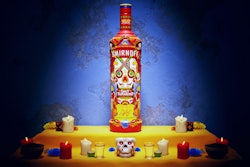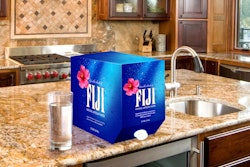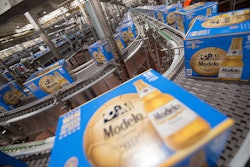
Packaging World:
What is the most common mistake heritage beer brands make when they try to redesign their packaging to appeal to a younger audience?
Troy Wade:
One of the biggest mistakes they make is that they throw away all the heritage of the brand. They say, “Oh this looks old-fashioned. It’s dialing up all sorts of cues from the past. So let’s throw all those away, and let’s make this thing modern.” In fact, there’s a classic example happening right under our noses, right this minute.
So Cobra Beer is an Indian beer [manufactured in the U.K. and India]. They’ve been building a brand for about 20 years, and they built it on their Indian heritage and Indian provenance. And now clearly the client said something like, “We want to appeal to a younger audience or to a newer generation, and we want something anyone in the world can access.” So they’ve completely thrown away everything they’ve built up over the last 20 years, and it lost all its Indian-ness, and now it just looks like a generic beer brand. So that’s kind of what I’m talking about. The idea is that they’ve thrown away all their provenance because they’re trying to appeal to a young audience, and so they’ve become nothing.
I mean, now it even says Cobra World Beer, and it’s got a yellow diamond with a green square in it. It used to have Indian writing. It used to show, embossed on the bottle, palm trees and Indian iconography. They dialed up the parts of India that were quite romantic—because India can have some very non-romantic connotations. But they definitely played beautifully into the romantic aspects of the country.
One of the comments I made in a discussion on the new brand on LinkedIn was, “I’m South African, but I currently live in London, and I’ve traveled the world. But in order to say that I’m a man of the world, does that mean that I have to give up the fact that I’m from South Africa? Or can I be a South African who’s got a global view?” Why does Cobra have to give up its Indian-ness in order to appeal to people who say that it belongs in the world? In fact, if anything, I don’t trust when people move to another country, and then they give up their heritage. I’m like, “Well, what happened? What went wrong? Why are you giving up where you came from? Why are you so ashamed of it? Why are you changing so radically? What’s wrong?”
So that’s sort of the first problem I think, because you want to appeal to someone young that means that we can’t be old, and actually, what we have learned about millennial consumers is that the term millennials is a huge, ambiguous label for an epic group of people that isn’t quite as nondescript. We have learned that they are actually buying less, but they are buying higher quality, and they’re looking for authenticity. So they want brands that have stories, they want brands that are paying attention to the environment and to social issues, and they want brands that stand for something that’s been built up over time.
So, what happens when you throw away all your heritage thinking you’re appealing to a younger audience is that you’re actually turning the younger audience off, because they see you as unauthentic. They are wondering why you’re trying to be hip; they’re wondering what’s wrong with the product if you are radically changing the packaging to the point where it’s no longer recognizable. And, you’re not actually appealing to one of the core tenets of how they choose products and brands, which is that they like things with back stories and authenticity.
At Brown&co, we do a lot of work in beer, and often the point at which a client comes to us is when they’ve tried to do this and it failed. Then they come to us and say, “Please help. How can we fix this?” And the first thing we always do is we say, “Right, we’re going to bring your history back.”
As a recent example, we worked with a brand in Turkey called EFES, which was the first beer in Turkey. They threw away all their heritage and provenance, and when we worked with them, we actually went back not just to the most recent pack that had heritage, which was about 2013, but we actually started with the 1965 pack. Because we thought the 1965 pack had even more heritage and even more provenance.
Why do you believe beer brands aimed at women have failed? What can mainstream beer brands do to appeal to women through package design?
One of the trends over the last 10 years or so has been that more and more women are drinking beer. So, of course all the big beer brands go, “Oh great, women like beer, so let’s make a beer brand for women.” They’ve done that, but I have yet to see a successful version. They try to make beer feminine. But what we’ve learned is that women aren’t drinking beer because they want it to be feminine, they’re drinking it because they like the masculinity of beer. And, from a branding perspective, women who are choosing beer are choosing it because it blurs the gender stereotype, and it says something about their version of femininity.
The thing is though, not all versions of masculinity appeal to women. We did a big project with SABMiller, and what we learned was that there is a modern masculinity that women find appealing. It’s a more open masculinity, it’s more friendly, less macho and aggressive. The mistake beer companies make is that they want to make a beer for women, so they make it look like a women’s beer. The solution is to keep making beer masculine, but with the certain type of masculinity that appeals to women.
Do you have an example of a beer that was designed to appeal to women?
This particular one I will share with you was actually designed and packaged to look like champagne, and it came in a pink box. It was called Aurosa [brewed in the Czech Republic], and it failed miserably.
What are some of the mistakes you’ve seen when heritage brands have redesigned their packaging to compete with craft beer?
Obviously the rise of craft beer was seen as a major threat to a lot of the big guys, who responded either by buying out some of the craft breweries and just absorbing them and turning them into their own brands, or by launching their own craft beer brand. Or, they turned an existing brand that wasn’t doing terribly well into some kind of craft offering. A lot of the time those strategies have failed because when someone knows a major beer manufacturer has gotten their hands on something, and they’re trying to make it look like something it’s not, it’s seen as inauthentic, and it lacks credibility.
The secret for corporate beer manufacturers and large-scale manufacturers to be successful is not to be something they’re not—you can’t be a craft beer brand or manufacturer if you are a massive company, so don’t try to be. Rather, play to your own strengths, which is that you know you can offer something that is consistent, you can offer great distribution, and your beer can be found everywhere. It’s something consumers can keep going back to, and they know what they’re going to get—the quality is going to be the same whenever they drink it.
Most of the big beer brands actually started out as little craft beer brands way back when. And because they were so good, and because they were successful, many people bought them, and that’s why they have made it large-scale now. Actually, most of the big beer manufacturers are where the little craft beer manufacturers want to be in a decade or two. They’re just a few steps ahead.
It also depends on how you define a craft beer. I have spoken with the heads of craft beer associations around the world, and some of the definitions of craft have to deal with size of manufacturer, so small quantities, small scale. But others don’t talk about size, they talk about the quality of ingredients or the amount of care that goes into the manufacturing of something. So, in some definitions of craft, you could actually be a massive brewery but still be considered a craft brewer because of the quality of your beer.
One example is Pilsner Urquell, which is brewed in the Czech Republic and was the very first lager beer every manufactured. I went to the brewery about two months ago to have a look, and its beer is made in a very craft way still, even though they’re brewing massive amounts of it. But it’s all brewed in one place, it’s made with single-source ingredients, and they don’t allow others to just produce it around the world under license; every drop has to be made within the Czech Republic under their supervision. So again, you could argue that even though they are a massive producer, there is more craft involved there than with a small manufacturer that is allowing people all over the world to make their beer under license.
What are some of the mistakes craft beers make in their package design?
A lot of the craft beers these days just seem to be rooted in nothing. It just seems to be what’s cool and what’s hip and what’s-the-next-out-there sort of beer-pack execution. But it doesn’t really say anything about the beer itself or help me understand the brewer, or what the brewing process is like, or what makes it different or better. So five years down the line, I still am no closer to understanding anything more than I was five years ago. The art of brand building is to help people understand things better over time. If you’re just trying to be funky and hip all the time, and that’s all you are, five years from now, you’re either still hip and funky, or you’re not, but no one has learned anything. You haven’t built any stickiness into the strategy along the way.
For example, if I blocked off the name of one of those craft beers and said, “Right, who makes this?” You’d probably go, “I don’t actually know, it’s just the yellow can with that really cool graffiti writing on it.” In terms of brand building, it feels like it’s all about the execution and all about the look, but it doesn’t feel like it’s anything more than that. You can be outdone by the next guy who comes in with the next coolest-looking can, and then your can isn’t so cool anymore, and you’ve got nothing else to fall back on.
It’s like the old marketing principle about never building your brand on price. So if you’re the cheap one, all it takes is someone else to come in and sell something cheaper than you, and then suddenly you stand for nothing. Craft brewers should be playing to the intrinsics of the product itself and perhaps a philosophy: “We stand for something different. We believe in something different. We approach this in a different way.” Build on foundations, build on rock instead of building on sand.
And that doesn’t limit creativity. I call them “liberating constraints”—they give you something to work from, which then at least gets your mind thinking in a certain way. And if you’re building on something, it can actually give you ideas and give you fodder, give you seeds from which to germinate thoughts. So rather than seeing it as something that limits you, I think it’s, “The sky is the limit.” Often, you just don’t know where to start, or you don’t know where to go, or you don’t know what you’re trying to achieve, so you kind of go nowhere. But craft beers need look at something a bit deeper: “What am I actually offering here that’s different? What am I offering here that’s better?”
If you’re a stout or a porter, and you’re rich and you’re dark, then maybe start with something that talks about the fact that you’re rich and you’re dark as a style. Or, if you’re a producer that stands for organic, or if you’re a producer that stands for non-alcohol, or for responsible drinking, or for anything, if you’re an overtly masculine brand, then something in what you do should always be about trying to help people understand that’s what you’re about, and that’s what you stand for. Because then, if there comes a time when you launch another beer, people will know you for something, and therefore, when you launch the new product, they’ll be more willing and more receptive to trying it because they’ll know the style they’re going to get.
An example would be Apple as a brand. If Apple launched a car tomorrow, I think a lot of people might buy an Apple car, even though Apple has never built a car before, because they’d say, “Well, Apple built it, and therefore it’s going to have a certain design ethic, it’s going to have a certain point of view, and I kind of know the kind of car I’m going to get from Apple.”
If was just, here’s a car and here’s a telephone and here’s a TV and here’s a music player that didn’t really have anything underpinning it all, you would just think, “Another music player.” If they launched a car, you’d go, “Well, I don’t know why I should buy this car because it’s just another car.”
That’s the problem a lot of craft brewers are making at the moment. They’re playing to all the trends, but they’re not playing to any sort of truth underneath those trends. That’s what they need to be focusing on. As I said earlier, millennials and young audiences want that sense of authenticity and something underpinning the brand. They want to buy something beyond the product, and they’re willing to spend more on it.
How do some craft beer brands grow big without losing their craft credentials, while others don’t?
In the U.K., there’s an excellent comparison you can make between Meantime Brewery and Brew Dog. They launched at roughly the same time about 10 years ago. Meantime is based in Greenwich, which is where the Greenwich meridian runs through, so that’s why they sell the Meantime concept. BrewDog started in Scotland. Then SABMiller bought Meantime, and of course, in the minds of consumers, Meantime Brewing sold out from being a craft brewery and got bought out by one of the big guys, and they lost a lot of their credibility. You start seeing all the cost savings in packaging and things becoming more generic, and you can sort of see how they’re trying to make it fit within a larger consortium of beer brands. They still make good beer, but they’ve become very much—and they feel very much—like another mainstream beer.
Whereas BrewDog, they have never sold out. They actually started selling shares in their business to consumers so anyone could own BrewDog. They were innovative and they grew, and now BrewDog is sold in 60 or 70 countries around the world, and it’s still growing exponentially. And even though it’s sold in so many parts of the world now, beer lovers still consider it a craft beer brand and still think it’s kept its credibility and authenticity.
And I think that’s the word: authenticity. I keep saying it, but I feel that’s the way you grow. You grow in a way that feel authentic, you stand for something, and you don’t ever bend your principles. You’re not seen as giving up on your values and your principles or your beliefs in order to make money, which is what Meantime seemed to do. Whereas BrewDog was always very clear about what they stood for at the beginning, and they still seem to be living those values and have retained their authenticity. And that’s how some craft brands have grown and remained authentic. It’s about that sense of knowing who you are and not giving that up for anything.

























